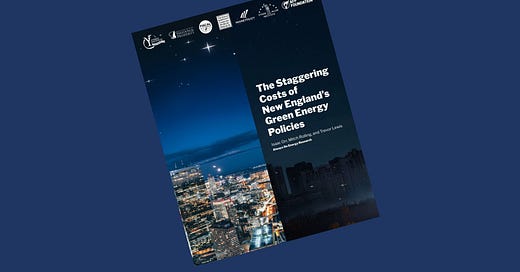Report says rolling blackouts could hit CT
Will ISO-NE, the region’s electricity grid, be to handle transition to ‘green’ energy and customer demand?
*This article was originally published by CT Mirror. It was co-authored by Bryce Chinault, Director of External Affairs at Yankee Institute.
In May 2022, Gov. Ned Lamont signed a law committing Connecticut to be 100 percent carbon-free by 2040, building on an executive order he signed in 2019. This ambitious goal includes benchmarks such as a 45 percent reduction in emissions from 2001 levels by 2030. At the same time, Connecticut has imposed an energy storage mandate of 1,000 megawatts (MW) by 2030 and is exploring an offshore wind venture with Rhode Island and Massachusetts.
While the environmental goals driving these policies are worth considering, a new joint report, The Staggering Costs of New England’s Green Energy Policies, raises serious concerns about their impact on Connecticut’s economy and residents’ quality of life.
The report, compiled by Always on Energy Research (AOER) in collaboration with Yankee Institute and other leading public policy organizations across New England, clearly demonstrates the costs and challenges associated with the region’s decarbonization plans. According to the findings, Connecticut’s electricity rates could double under the current trajectory. What’s more, the region could face rolling blackouts as the push for “green” energy like wind and solar fails to meet growing electricity demands.
Compliance with the New England Decarbonization Plans — efforts to achieve net-zero — would cost $815 billion through 2050. Meanwhile, Connecticut families would see their electric bills increase by an average of nearly $99 per year; costs for commercial businesses would increase by $489 per year; and the electric bills for industrial (manufacturing) customers would skyrocket by an average of almost $5,280 per year.
The report also finds that a shift to green energy as the region’s primary energy source is not entirely feasible for the electrical grid of ISO-New England — an independent, not-for-profit corporation responsible for keeping electricity flowing across the six New England states. ISO- NE simply may not be able to power the region within 11 years, so should New England states stay on the same “renewable-intensive path, a blackout scenario could be dire indeed.”
Certainly, a clean environment is an important and worthy goal, but New England is responsible for less than 0.4% of global emissions. Indeed, if Connecticut and the rest of New England are to supply homes and businesses with constant electricity during a year in which wind and sunshine are plentiful, 225 gigawatts (GW) of renewables would be required — more than 12,000 wind turbines and 129 million solar panels. But in a cloudier year with less wind, even 225 GW wouldn’t be enough — and blackouts should be expected.
Beyond the financial burden, the risks posed by an unreliable energy grid are dire. In New England, 87% of households rely on electricity for heat during the cold winter months, whether from natural gas, heating oil, or heat pumps. For vulnerable populations — the elderly, the sick, or those relying on medical devices like dialysis machines — power outages aren’t just inconvenient; they’re life-threatening. A more unreliable grid means more fatalities, especially in the harsh winter months.
Despite these grave concerns, some Connecticut policymakers are once again considering policies that could accelerate the move toward green energy, potentially enacting a “Green Monster” or a “Green Amendment” that would only deepen these challenges.
It’s time for Connecticut to hit pause and rethink this trajectory. We need a sensible energy policy that balances the need for environmental stewardship with economic growth and energy reliability. The policies being considered today threaten not just our wallets, but also our safety and the well-being of our most vulnerable residents.
Connecticut should not move forward with untested, costly, and risky energy policies that leave residents in the dark — both figuratively and literally. It’s time for a smarter, more balanced approach to energy that ensures the health of our environment without compromising the health and financial security of our residents and businesses.



